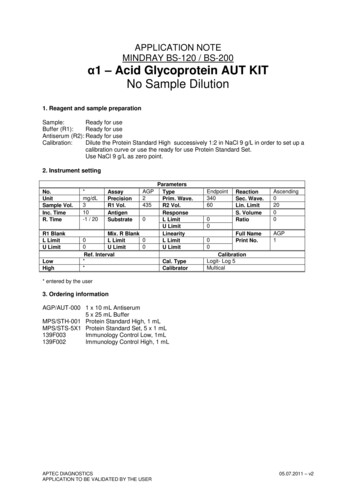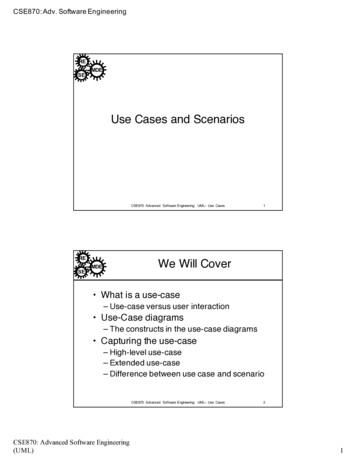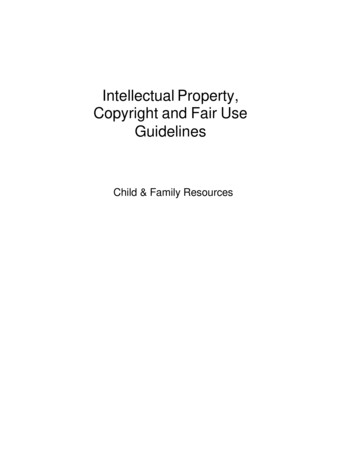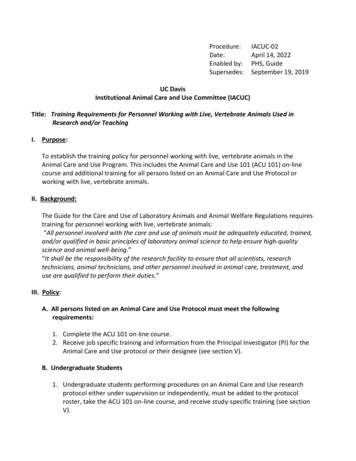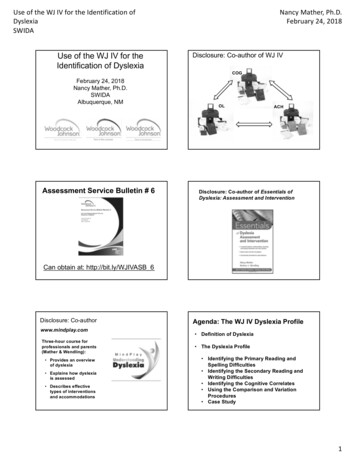
Transcription
Use of the WJ IV for the Identification ofDyslexiaSWIDAUse of the WJ IV for theIdentification of DyslexiaNancy Mather, Ph.D.February 24, 2018Disclosure: Co-author of WJ IVCOGFebruary 24, 2018Nancy Mather, Ph.D.SWIDAAlbuquerque, NMAssessment Service Bulletin # 6OLACHDisclosure: Co-author of Essentials ofDyslexia: Assessment and InterventionCan obtain at: http://bit.ly/WJIVASB 6Disclosure: Co-authorwww.mindplay.comThree-hour course forprofessionals and parents(Mather & Wendling): Provides an overviewof dyslexia Explains how dyslexiais assessed Describes effectivetypes of interventionsand accommodationsAgenda: The WJ IV Dyslexia Profile Definition of Dyslexia The Dyslexia Profile Identifying the Primary Reading andSpelling Difficulties Identifying the Secondary Reading andWriting Difficulties Identifying the Cognitive Correlates Using the Comparison and VariationProcedures Case Study1
Use of the WJ IV for the Identification ofDyslexiaSWIDACharlie, 3rd Grade Strengths in:–Mathematics–Oral vocabulary–Academicknowledge Weaknesses in:–Word identification–Word perceptionspeed–SpellingBritish Dyslexia AssociationThe word 'dyslexia' comes from the Greekand means 'difficulty with words'.Definition: Dyslexia is a specific learningdifficulty which mainly affects thedevelopment of literacy and language relatedskills. It is likely to be present at birth and tobe lifelong in its effects. It is characterised bydifficulties with phonological processing,rapid naming, working memory, processingspeed, and the automatic development ofskills that may not match up to anindividual s other cognitive abilities.Nancy Mather, Ph.D.February 24, 2018International Dyslexia Association (2003)defines dyslexia as:[A] specific learning disability that is neurobiologicalin origin. It is characterized by difficulties withaccurate and/or fluent word recognition and by poorspelling and decoding abilities. These difficultiestypically result from a deficit in the phonologicalcomponent of language that is often unexpected inrelation to other cognitive abilities and the provisionof effective classroom instruction. Secondaryconsequences may include problems in readingcomprehension and reduced reading experiencethat can impede growth of vocabulary andbackground knowledge.The phonological deficit view that has dominatedthe field for years is inadequate for explaining allcases of reading disorder (Peterson & Pennington,2012; Snowling & Hulme, 2012 and its importancehas been overstated (Swanson, Trainin,Necoechea, & Hammill, 2003).Peterson, R. L., & Pennington, B. F. (2012). Developmentaldyslexia. The Lancet, 379(9830), 1997–2007.Snowling, M. J., & Hulme, C. (2012). Annual research review:The nature and classification of reading disorders—acommentary for proposals on DSM-5. Journal of ChildPsychology and Psychiatry, 53, 593–607.Swanson, H. L., Trainin, G., Necoechea, D. M., & Hammill, D.D. (2003). Rapid naming, phonological awareness, andreading. A meta analysis of the correlational evidence.Review of Educational Research, 73, 407–444.Consensus on the DefinitionPennington , B. F. ( 2009 ). Diagnosing learning disorders: Aneuropsychological framework (2nd ed. ). New York, NY: Guilford Press. Neurobiological disorder that affects thedevelopment of basic reading skills, spelling,and automaticity with sound-symbolconnections. It is often accompanied by specificweaknesses in cognitive factors that predictpoor reading and spelling. It is a lifelong condition but effectiveinterventions reduce the impact. Many other abilities are often intact and caneven be advanced.2
Use of the WJ IV for the Identification ofDyslexiaSWIDAThe Dyslexia Profile forUse with the WJ IVCreated by: Drs. C. Proctor, N. Mather, T.Stephens-Pisecco, and L. E. Jaffe (2016). Highlights the cognitive, linguistic, andachievement abilities that are mostrelevant to dyslexia. Provides a format for exploring bothdiscrepancies and comparisons. Highlights an individual’s strengths andweaknesses.Nancy Mather, Ph.D.February 24, 2018Benefits of the Profile Provides a way to organize data regardingconsideration of whether or not a person hasdyslexia. May be used with WJ IV COG, WJ IV ACH andWJ OL, or all three batteries. Saves time for the examiner. Helps focus the evaluation to the main resultsthat are most relevant to a diagnosis of dyslexia.Identifying the Primary Reading andSpelling DifficultiesDevelopment and Acquisition of: Sound-letter (phoneme-grapheme)associations Basic reading skills–Phonics and sight word reading Rate (automaticity) of reading and spelling SpellingIdentifying the Primary Readingand Spelling DifficultiesIdentifying the Primary Readingand Spelling DifficultiesWJ IV ACH Reading/Spelling Clusters and TestsWJ IV ACH Test 8: Oral Reading Phoneme-Grapheme Knowledge – Word Attack, Spelling of Sounds Measures phonic skillsBasic Reading Skills– Letter-Word Identification, Word AttackReading Rate– Sentence Reading Fluency, Word Reading Fluency Silent reading rateTwo spelling tests– Spelling, Spelling of Sounds Contributes to the Reading Fluencycluster. Individual reads increasingly difficultsentences aloud. Similar to an informal reading inventory. Good first test to administer in a readingevaluation.3
Use of the WJ IV for the Identification ofDyslexiaSWIDAIdentifying the Secondary Reading andWriting Difficulties Reading Comprehension Written Expression Vocabulary and KnowledgeNancy Mather, Ph.D.February 24, 2018Reading Comprehension“Individuals with problems in readingcomprehension that are not attributableto poor word recognition havecomprehension problems that aregeneral to language comprehensionrather than specific to reading” (p. 3).Source: Spencer, M., Quinn, J. M., Wagner, R. K. (2014).Specific reading comprehension disability: Major problem, myth,or misnomer? Learning Disabilities Research & Practice, 29, 3-9.Cognitive Correlates Are related cognitive and linguisticfactors that affect the development ofreading and spelling skill. They predict difficulties with readingand spelling development. Some are more trainable than others(e.g., phonological awareness vs.working memory).Cognitive and LinguisticCorrelates of Dyslexia Attention Phonological Processing Orthographic Processing Memory Rapid Automatized Naming (RAN) Processing Speed484
Use of the WJ IV for the Identification ofDyslexiaSWIDAPhonological ProcessingOral Language AbilityThe ability to hear and manipulate thespeech sounds in words.Nancy Mather, Ph.D.February 24, 2018Phonological ProcessingWJ IV COG Test 5: PhonologicalProcessingMeasures three different aspects of speech soundprocessing: Word Access– “Tell me a word that starts with the /ch/ sound.” Word Fluency– Timed for 1 minute; words that begin with a sound. Substitution– Substitute one sound in a word for another; change the/s/ in sun to /f/.Phonological ProcessingWJ IV COG (Extended) Test 12:Nonword Repetition Listen to and repeat nonsense words thatincrease in length (e.g. zab,philistationing) Measures phonological short-termmemory for speech sounds Related to both speech/languageimpairments and dyslexiaPhonological ProcessingWJ IV OL Test 3: SegmentationThis test combines with Blending to form the WJIV OL Phonetic Coding cluster, and includes thetwo most important early phonologicalawareness abilities: Blending Pushing speech sounds together Underlies using phonics for reading Segmentation Pulling sounds apart Underlies breaking apart sounds for spelling Although their skills differ, students withdyslexia have poorer nonword repetitionskills when compared to age peers andreading-level controls. Variability in performance is predicted byoral language skills. Students with combined dyslexia andspecific language disorders have the mostsevere nonword repetition impairments.Melby-Lervag, M., & Lervag, A. (2012). Oral language skillsmoderate nonword repetition skills in children with dyslexia: Ameta-analysis of the role of nonword repetition skills in dyslexia.Scientific Studies of Reading, 16, 1-34.Segmentation Compound Words Syllables Phonemes (single speechsounds)5
Use of the WJ IV for the Identification ofDyslexiaSWIDAPhonological ProcessingWhen to administer Blendingand Segmentation If Word Attack (reading phonically regularnonsense words) is average or aboveaverage: no need to administer Blendingand Segmentation.Nancy Mather, Ph.D.February 24, 2018Phonology and OrthographyPhonology: the sounds of a languageOrthography: the marks of a writingsystem, including the spelling patternsDyslexia can be caused by problems inphonology or orthography or both. If Word Attack is below average:administer Blending and Segmentation.Orthographic AwarenessWorking MemoryTest 4: Letter-Pattern Matching Provides a measure ofperceptual speed andorthographic processing. Good readers and spellerswill quickly note thematching pair which is acommon English spellingpattern (e.g., th, oa); theothers are not (e.g., ao,hx). Ability to hold information andthen re-order/re-arrange itwithin a short period of time Requires memory as well asattentional controlShort-term Working MemoryAssociative MemoryWJ IV COGVisual-Auditory Paired Associate Learning (PAL) Test 3: Verbal Attention Listen to a string of numbers and animals,then answer a question. Test 10: Numbers Reversed Listen to, then repeat, a string of digits inreverse order. Test 16: Object-Number Sequencing Listen to a string of things and numbers. Thenlist the things. After things, list the numbers.“ recent research suggests that visualverbal PAL may be a unique crossmodal associative learning mechanismthat is specific to the creation ofmappings between visual (orthographic)and phonological stimuli ” (p. 46).Warmington, M., & Hulme, C. (2012). Phoneme awareness,visual-verbal paired associate learning, and rapid automatizednaming as predictors of individual differences in readingability. Scientific Studies of Reading, 16, 45-62.6
Use of the WJ IV for the Identification ofDyslexiaSWIDA“ the learning of mappings betweenorthography and phonology is critical forlearning to read and likely operates atnumerous levels, including the process oflearning letter-sound correspondences andthe learning of mappings at the level of singleletters, letter groups, and whole words whenacquiring a word recognition system” (p. 47).Warmington, M., & Hulme, C. (2012). Phoneme awareness, visual-verbalpaired associate learning, and rapid automatized naming as predictors ofindividual differences in reading ability. Scientific Studies of Reading, 16, 4562.(d) pause time is significantly correlatedwith reading accuracy and fluency,whereas articulation time is not.Nancy Mather, Ph.D.February 24, 2018Research Findings regarding RAN(a) RAN letters and then numbers are thestrongest predictors of both reading and spelling.(b) RAN is distinct from phonologicalawareness.(c) the contribution of RAN is larger for youngerreaders and readers with more severe readingdisabilities.Rapid NamingWJ IV OL Test 4: Rapid PictureNaming(e) RAN is more highly related to speededmeasures of reading than accuracy.A modified RAN task that along withRetrieval Fluency contributes to theSpeed of Lexical Access cluster.(f) RAN is a good predictor oforthographic skills, but not phonic skills.Examinee is asked to name picturesof common objects quickly.Processing SpeedPerceptual SpeedWJ IV COG Tests The ability to perform simple clericaltasks quickly using symbols such asletters or numbers Related to orthographic processing andthe acquisition of basic skills WJ IV COG Test 4: Letter-PatternMatching WJ IV COG (Extended) Test 11:Number-Pattern Matching Relevant to a need for extended time7
Use of the WJ IV for the Identification ofDyslexiaSWIDANancy Mather, Ph.D.February 24, 2018Cognitive EfficiencyTim’s Cognitive AbilitiesWJ IV COG TestsA measure of short-term working memory andperceptual speed.CLUSTERSSSRPIProficiencyImplicationsFLUID REASONING11397/90avg to adveasyVISUAL PROCESSING10090/90averagemanageablePHONEMIC AWARE13198/90advancedeasy Test 4: Letter-Pattern MatchingAUDITORY MEM SPAN11197/90avg to adveasyL-T RETRIEVAL (Glr)10993/90averagemanageable Test 10: Numbers ReversedWORKING MEMORY8554/90limitedvery difficultPERCEPTUAL SPEED7356/90limitedvery difficultStandard ClusterExtended Cluster WJ IV COG Test 3: Verbal Attention Test 11: Number-Pattern MatchingTim’s Oral Language andReading Grade 6CLUSTER/TestSSRPIProficiencyImplicationsORAL LANG10492/90averagemanageableWord Attack8016/90very limitedextremely difficultLetter-Word Identif.8639/90limitedvery difficultPassage Compre8452/90limitedvery difficultReading Fluency7545/90limitedvery difficultConclusion:READINGMultiple cognitive and linguisticabilities can impact reading andspelling development.Difficulties and CorrelatesSummary“Perhaps the most significant contribution of thisbody of work for practitioners at the current time is to demonstrate the need for caution againsttoo great an adherence to an overly simplisticphonological model” (p. 81).A greater emphasis is needed on the role of underlyingauditory, visual and attentional factors.Source: Elliott, J. G., & Grigorenko, E. L. (2014). The dyslexiadebate. New York, NY: Cambridge University Press.Dr. Alan Kaufman there is a demand for thecomprehensive assessment to driveintervention. This is the way it hasalways been, and this is the way itwill always be because the referralquestions for children with SLDhave always asked, What is wrong?And how can we help? Thesequestions demand differentialdiagnosis, a large part of which isdetermined by the cognitiveabilities present in the individualchild (p. 211).Source: Kaufman, A. S., Lichtenberger, E. O., Fletcher-Janzen,E., & Kaufman, N. L. (2005). Essentials of the K-ABC-IIAssessment. New York: John Wiley & Sons.8
Use of the WJ IV for the Identification ofDyslexiaSWIDAThe primary purposefor testing should beto find out more aboutthe problem, not tojust get a score.Nancy Mather, Ph.D.February 24, 2018And to find more about the factorsthat will facilitate performance We shouldn t ask:How smart youare but instead:How are you smart?- H. GardnerDocumenting Intact Abilities Determine the relevant andrelative strengths (intactabilities) for the person’s ageand the educational andvocational demands.C. Ability to Learn When Reading is Not RequiredCheck the areas that are significantly higher than the individual’s reading andspelling skills.Oral LanguageOral Math calculationskillsMath problemsolvingKnowledgeGeneral information4Academic knowledge4 Can use the WJ IV Comparisonand Variation procedures todocument both strengths andweaknesses.Essence of a Learning DisabilitySea of Strengths Model of DyslexiaBasic concept of a PSW approach“ generalized integrity and adeficiency in learning (p. 9) there is adeficit in learning in the presence ofbasic integrity” (p. 25).Source: Johnson, D. J., & Myklebust, H. R. (1967).Learning disabilities: Educational principles andpractices. New York: Grune & lemsolvingVocabularyShaywitz, S. (2003). Overcoming dyslexia: A new andcomplete science-based program for reading problems atany level. New York: Alfred A. Knopf. (p. 58)9
Use of the WJ IV for the Identification ofDyslexiaSWIDAProcedures for DyslexiaIdentificationComparisons and Variations Comparisons (or discrepancies): a score used toNancy Mather, Ph.D.February 24, 2018Procedures for Dyslexia IdentificationTwo Basic ConceptsUnexpected underachievementExpected underachievementpredict performance in an area– Predicted score is based on score of the predictor(e.g., Broad Oral Language cluster to Basic ReadingSkills) Variations: a comparison of abilities to identify apattern of strengths and weaknesses– Predicted score is based on a core set of otherabilitiesProcedures for Dyslexia IdentificationProcedures for Dyslexia IdentificationBasic Concepts - Unexpected UnderachievementBasic Concepts - Expected UnderachievementReading performance is below whatwould be predicted based upon one’sother cognitive/linguistic and/oracademic abilities (e.g., oralvocabulary, math). (Discrepancymodel).Reading performance is in line withcognitive/linguistic weaknesses- theweakness(es) predict the pooracademic performance (e.g., poorphonological awareness predictspoor phonics skills). (Consistencymodel)Procedures for Dyslexia IdentificationProcedures for Dyslexia IdentificationBasic ConceptsBasic Concepts“We are coming to recognize thatdeficiencies in certain cognitiveprocesses are indicators of LD thatpredict and, therefore, result inexpected underachievement” (p. 239).Source: Learning disabilities: Implications for policy regardingresearch and practice: A report by the National Joint Committeeon Learning Disabilities March 2011. Learning DisabilityQuarterly, 34, 237-241.Cognitive strengths(e.g., language,reasoning) predictintact performance.Intact performancein academic areasnot affected by thereading disability(e.g., nitiveWeaknesses (e.g.,phonologicalawareness,perceptual speed)predict weaknessesin d spellingability, slowreading rate.10
Use of the WJ IV for the Identification ofDyslexiaSWIDA“Knowledgeable practitioners also useclinical judgment to determine whichapproach is applicable for a given child orin a given school setting. While regulationsand policies require school districts toimplement a single approach, best practicemay reside somewhere in the margins witha hybrid model” (p. 6).Source: Kovaleski, J. F., Lichtenstein, R., Naglieri, J.,Ortiz, S. O., Klotz, M. B., & Rossen, E. (2015). Currentperspective in the identification of specific learningdisabilities. Communique, 44(4), 4, 6.Nancy Mather, Ph.D.February 24, 2018Two Procedures for DyslexiaIdentification Comparisons (discrepancies) betweenoverall ability (Gf-Gc Composite,General Intellectual Ability) or OralLanguage Ability, AcademicKnowledge) and reading performance Variations among abilities: a pattern ofstrengths and weaknesses (intraindividual variations)Procedures for Dyslexia EvaluationCompare Cluster Scores to:Three Most Relevant Clusters for AbilityAchievement ComparisonsWJ IV Tests of Achievement WJ IV Tests of Cognitive Abilities Gf-Gc Composite/Other Ability WJ IV Tests of Oral Language Broad Oral Language Cluster WJ IV Tests of Achievement Basic Reading Skills Phoneme-Grapheme Knowledge Reading Fluency Reading Rate Academic Knowledge ClusterProcedures for Dyslexia EvaluationProcedures for Dyslexia EvaluationSome Abilities are More Important than OthersGf-Gc/Other AbilityReasoning (Gf)Oral Language (Gc)Compares Gf-Gc composite to current levels ofachievement or oral language abilities or othercognitive abilities to determine if a discrepancyexists. Requires Gf-Gc composite (WJ IV COG Tests 1, 2,8, 9)Phonological Awareness (Ga)Perceptual Speed (Gs) Determines the presence of significant strengths orweaknesses between an individual’s higher-level,more complex abilities (reasoning and knowledge)and his or her achievement, and other abilities(cognitive or oral language)11
Use of the WJ IV for the Identification ofDyslexiaSWIDANancy Mather, Ph.D.February 24, 2018Procedures for Dyslexia IdentificationProcedures for Dyslexia IdentificationGf-Gc/Other AbilityAdditional ResourcesCognitive AbilitiesGf-GcCompositeOral LanguageAchievementCan obtain at: http://bit.ly/WJIVASB3 under AdditionalResources.In general, many students with dyslexia have higherscores on measures of: Oral languageProcedures for DyslexiaIdentificationComparison of Oral Language to Reading Tests KnowledgePredictor Reasoning MathematicsBroad Oral Languagewith lower scores on measures of:Clusters for Comparison Basic Reading Skills Phoneme-Grapheme Basic reading skillsIs reading achievementin line with orallanguage ability? Reading fluency and rateKnowledge Reading Fluency and Rate Spelling Specific cognitive correlatesProcedures for DyslexiaIdentificationProcedures for Dyslexia IdentificationVerbal Ability as an Estimate of Reading PotentialOral Language tests to Reading testsOral LanguageReadingStory RecallReading RecallOral VocabularyReading VocabularyOral ComprehensionPassage ComprehensionChildren should be able tocomprehend, or construct, themeaning of what is being read at alevel consistent with their generalverbal ability (p.55).Source: Torgesen, J. K. (2000). Individual differences inresponse to early interventions in reading: The lingeringproblem of treatment resisters. Learning Disabilities Research& Practice, 15, 55-64.12
Use of the WJ IV for the Identification ofDyslexiaSWIDANancy Mather, Ph.D.February 24, 2018AcademicKnowledge/ReadingComparisonsStrengths Academic Knowledge is used to predictachievement; full length tests of Science,Social Studies, and Humanities areadministered orally Academic Knowledge can be compared to allreading and writing clusters Helps determine if reading and writing arediscrepant from Academic KnowledgeWeaknessesOral languageand reasoningDecoding, spelling,speed of wordperceptionProcedures for Dyslexia EvaluationProcedures for Dyslexia EvaluationFour Variation ProceduresCore Tests Intra-Cognitive Intra-Oral Language WJ IV COG: Tests 1-7 Intra-Achievement Academic Skills/AcademicFluency/Academic Applications WJ IV OL: Tests 1-4Four variation procedures help document anindividual’s pattern of strengths and weaknessesbased on the “core” tests in each battery.Cognitive Standard Battery(Tests 1-10)Test 1: Oral Vocabulary (Gc)Test 2: Number Series (Gf)Test 3: Verbal Attention (Gwm)Test 4: Letter-Pattern Matching (Gs)Test 5: Phonological Processing (Ga)Test 6: Story Recall (Glr)Test 7: Visualization (Gv)Test 8: General Information (Gc)Test 9: Concept Formation (Gf)Test 10: Numbers Reversed (Gwm) WJ IV ACH: Tests 1-6Intra-AchievementVariation ProceduresCore Tests (1-7)GIARequired forIntra-COGVariation6 Core tests –average other 5 toobtain the predictor13
Use of the WJ IV for the Identification ofDyslexiaSWIDAFor additional tests and clusters, thepredicted score is based on the samepredictor as the core test (ACH 1-6) thatmeasures a similar skill.Example:If Test 7: Word Attack were administered, boththe Word Attack test and Basic Reading Skillscluster would be added into the variationprocedure. They would be compared to thesame predictor (the average of the other 5 coretests-Tests 2-6) as Test 1: Letter-WordIdentification, a measure of basic reading skills.Nancy Mather, Ph.D.February 24, 2018Cross-Academic ClustersReadingMathWrittenLanguageAcademic Skills/Fluency/ApplicationRandy, Grade 11Within the WJ IV ACH, you can compare: Academic Skills (basic academic skills) Academic Fluency (timed measures) Academic Applications (problem solvingand reasoning)Many individuals with dyslexia will have:Academic Applications cluster AcademicSkills or Academic Fluency clusters.161WJ III Academic Fluency Clusterwas the single most importantvariable in differentiating betweencollege students with and withoutlearning disabilities.CHC CFA of WJ-III, WAIS-III, WMS-III and KAIT- University Studentswith and without LD(McGrew, Gregg, Hoy, Stennett, Davis, Knight, Coleman & Ford, 2001)Reading Fluency/Rate Clusters Reading Fluency (Oral and Silent Reading)–Oral Reading (Oral)–Sentence Reading Fluency (Silent) Reading Rate (Silent Reading)–Sentence Reading Fluency–Word Reading Fluency14
Use of the WJ IV for the Identification ofDyslexiaSWIDAD. At-Risk IndicatorsCheck the areas below that are additional at-risk factors.Family historyEarly speech-language concernsTwo questions you want to ask:Did anyone in the family have difficultylearning to read?Did the student have difficulty withspeech or language development?Reason for Referral Brayden’s mother is concerned about his strugglewith reading despite numerous interventions inthe past The conclusion from prior testing has alwaysbeen that the problem is “developmental” withthe assumption that he will catch up. Teachers have expressed concerns about effortand attention. The mother wishes to know what factors areimpeding performance and what they can do tohelp their son.Intra-Achievement VariationsNancy Mather, Ph.D.February 24, 2018Hereditary FactorsStrong converging evidence suggeststhat:1. Dyslexiahas a genetic basis butthere is not one specific gene forreading.2. Family history is a key riskindicator.Brayden Grade 3.8 Age 9-8Moved states and schools five timesHome schooled at timesIntra-Cognitive Variations15
Use of the WJ IV for the Identification ofDyslexiaSWIDAIntra-Cognitive VariationsGf-Gc Composite ComparisonAcademic Knowledge/Achievement ComparisonsNancy Mather, Ph.D.February 24, 2018Intra-Oral Language VariationsGIA/Achievement ComparisonsPossible Recommendations Consult with Brayden’s pediatrician regardingADHD. Collect rating scales from last year’s teachers. Consider eligibility for SLD services. Provide preferential seating in the front of theroom near the teacher’s desk. Break assignments into smaller segments. After listening to directions, ask Brayden toparaphrase what he is supposed to do.16
Use of the WJ IV for the Identification ofDyslexiaSWIDANancy Mather, Ph.D.February 24, 2018Reading Begin an online reading intervention, MindplayVirtual Reading Coach (MVRC), 30 minutes 5times a week during the summer, continuing intothe school year (www.mindplay.com). Continue working with a reading specialist whounderstands evidence-based reading instruction;the initial instruction should focus on structuralanalysis, breaking words into parts to make themeasier for Brayden to pronounce.Failure to learn to read as othersdo is a major catastrophe in achild’s life (p.1).MathematicsContinue tutoring in mathematics: Reteach the concept of place value. Review two-digit multiplication. Review simple division. Provide practice counting money.Consider use of an online math program, suchas ALEKS to supplement y ignorance of my dyslexia only intensifiedmy sense of isolation and hopelessness.Ignorance is perhaps the most painful aspectof a learning disability.” (p. 64).Source:Dolch, E. W. (1939). A manual for remedialreading. Champaign, IL: Garrard Press.SummarySource: Schultz, P. (2011). My dyslexia. New York, NY: W. W.Norton & Company.Diagnosis and InstructionWhen identifying dyslexia, consider: Weaknesses in phonics, sight wordidentification, reading fluency and rate,and spelling Weaknesses in specificcognitive/linguistic abilities“Diagnosis must take second placeto instruction, and must be made atool of instruction, not an end initself.” Relative strengths in other areas, suchas oral language, reasoning,mathematics, knowledgeSource: Cruickshank, W.M. (1977). Least-restrictiveplacement: Administrative wishful thinking. Journal ofLearning Disabilities, 10, 193-194.17
Use of the WJ IV for the Identification ofDyslexiaSWIDANancy Mather, Ph.D.February 24, 2018The Value of Tests“If these tests will give us a basis from which wecan start to understand a child’s difficulties, theywill have justified the time spent on them.Anything which helps educators or parents tounderstand any phase of development or lackof development is of immeasurable value”(p. 189).Source: Stanger, M. A., & Donohue, E. K. (1937). Prediction andprevention of reading difficulties. New York, NY: OxfordUniversity Press.18
DYSLEXIA PROFILE(For use with the WJ IV1)NameDate of BirthIDSchoolGradeTesting DateThe [name of state] Education Code [§ statute number] [or country] defines dyslexia in the following way:International Dyslexia Association Definition (2002)Dyslexia is a specific learning disability that is neurological in origin. It is characterized by difficulties with accurate and/or fluent wordrecognition and by poor spelling and decoding abilities. These difficulties typically result from a deficit in the phonological componentof language that is often unexpected in relation to other cognitive abilities and the provision of effective classroom instruction.Secondary consequences may include problems in reading comprehension and reduced reading experience that can impede thegrowth of vocabulary and background knowledge.Authors’ note: Dyslexia affects reading at the single word level, reading fluency and rate, and spelling. In turn, these deficits causedifficulties with reading comprehension and written expression. According to research, the major cognitive correlates of dyslexiainclude weaknesses in one or more of the following abilities: phonological awareness, orthographic awareness, memory, rapidnaming, and processing speed. Other abilities, such as general intelligence, reasoning, oral language, mathematics, and knowledge, thatdo not require reading, are often unimpaired. In other words, the reading and spelling difficulties are often unexpected in relation to thestudent’s other abilities.Section I: SummaryA. Primary and Secondary Reading, Spelling, and Writing DifficultiesCheck the areas of concern.Primary Reading and Spelling DifficultiesSecondary Reading and Writing DifficultiesLetter-sound associationsLetter namesLetter soundsBasic reading skillsSight word identificationPhonics (nonword/word decoding)Reading fluency and rateSpellingin isolationin contextReading comprehensionWritten expressionB. Cognitive and Linguistic Abilities: Possible Contributing FactorsCheck the areas that are possible contributing factors.Phonological awareness2Auditory processingPhonetic codingOrthographic awareness3MemoryAuditory memory spanShort-term working memoryAssociative memoryRapid namingProcessing speedC. Ability to Learn When Reading is Not RequiredCheck the areas that are significant
This test combines with Blending to form the WJ IV OL Phonetic Coding cluster, and includes the two most important early phonological awareness abilities: Blending Pushing speech sounds together Underlies using phonics for reading Segmentation Pulling sounds apart Underlies breaking apart sounds for spelling





